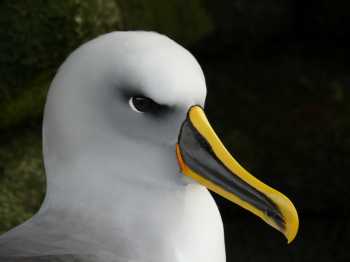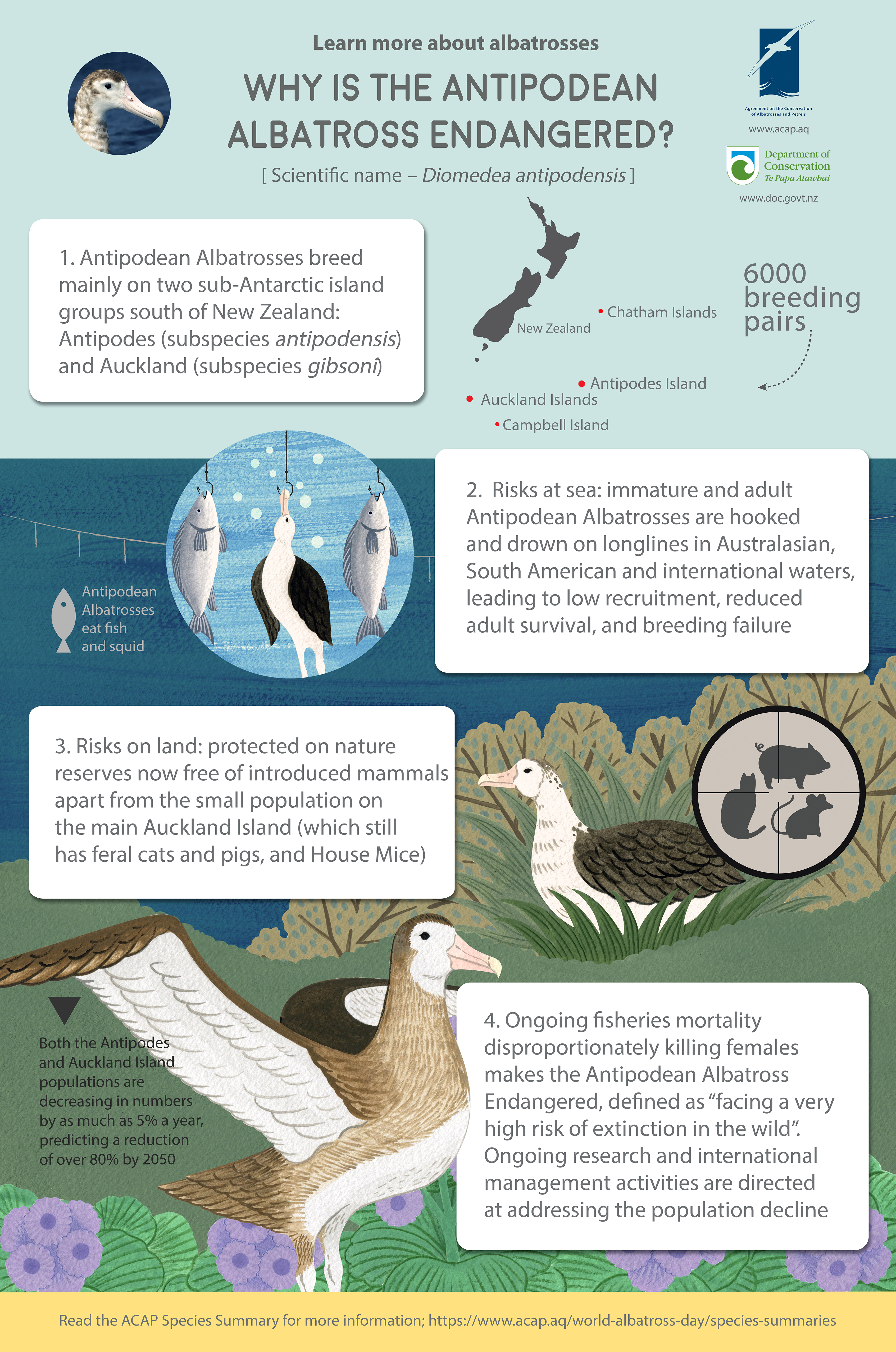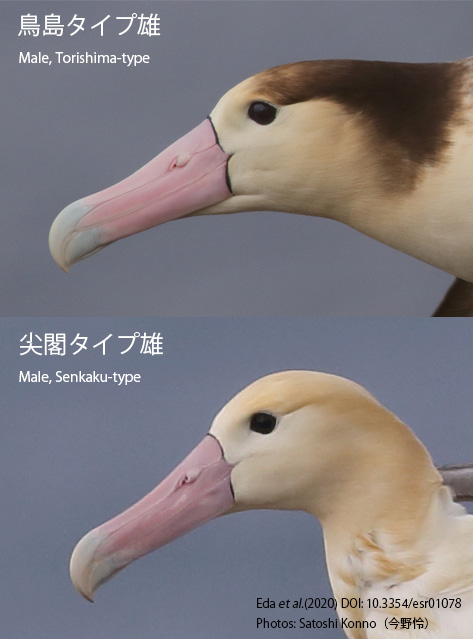
Southern Buller's Albatross, Snares Islands, April 2007, photograph by Paul Sagar
The Albatross and Petrel Agreement recognizes 22 species of albatrosses, all of which it lists under its Annex 1. Distinct breeding populations of two of these species continue to be variously treated in the professional and popular literature (and on social media) either at the subspecific or specific level; a third albatross, hitherto thought not to vary taxonomically (“monophyletic”) has recently been proposed to consist of two species. The question thus arises should there be 22 or 25 species of albatrosses? In this Monthly Missive I consider the taxonomic status of these three albatross species, primarily based on reviews summarized by ACAP’s Taxonomy Working Group (TWG) in its reports to meetings of the ACAP Advisory Committee.
Buller’s Albatross
New Zealand’s endemic Buller’s Albatross Thalassarche bulleri occurs in two distinct populations. These have been treated either as subspecies or as distinct species in the literature. The northern population T. (b.) platei (sometimes referred to as the Pacific Albatross) breeds in the Chatham Island group (Rangitatahi/Three Sisters and Motuhara/Forty-Fours) and on Rosemary Rock, Manawatāwhi/Three Kings Islands. The southern population T. (b.) bulleri breeds on the Solander and Snares Islands. The two populations breed around two months apart with the northern population laying eggs in October-November and the southern birds over January and February. At least some field guides consider they can be identified by plumage and other differences. According to New Zealand Birds Online “the two subspecies are separated by bill size and colour and head plumage. Southern Buller’s mollymawk has a silvery-white forehead with black extending over about 70% of the sides of the bill. Northern Buller’s mollymawk has a silvery-grey forehead with black extending over about 80% of the sides of the bill. In addition, the bill of northern Buller’s mollymawk is more robust (longer and deeper) than that of the southern Buller’s mollymawk”.
In 2006 the TWG evaluated the taxonomic status of Buller’s Albatross and in its report (AC2 Doc 11 to the 2nd Meeting of the ACAP Advisory Committee, recommended the northern and southern populations be recognized as subspecies, this then being supported by the committee. This year the TWG reevaluated the situation following new genetic evidence, recommending to the 13th Meeting of the Advisory Committee that the two populations’ subspecific status should be retained (AC13 Doc 10 Rev 1). It commented that “no statistical analyses of morphometric data have been published for these taxa”, suggesting the need for a study. MSc anyone?
Antipodean Albatross

The Albatross and Petrel Agreement recognizes four species within the “wandering” group of great albatrosses in the genus Diomedea. These are the Amsterdam D. amsterdamensis, the Tristan D. dabbenena, the Wandering D. exulans and the Antipodean D. antipodensis. The first three species are regarded as monophyletic by ACAP and most authorities. The Antipodean Albatross, a New Zealand endemic, is recognized by ACAP as having two subspecies, the nominate D. a. antipodensis, which breeds on Antipodes Island, and the “Gibson’s” race D. a. gibsoni, which breeds on the Auckland Islands. However, this view is not held by all authorities, with some awarding full species status to the two subspecies, as set out in detail on the TWG’s 2006 Report (AC2 Doc 11) to the Second Meeting of the ACAP Advisory Committee. Following its literature review the working group recommended that the two subspecies did not warrant specific status. It did, however, recognize that little or no gene flow occurs between the two taxa; that D. a. antipodensis tends to be darker than D. a. gibsoni, and that it is likely D. a. antipodensis forages more frequently in the eastern Pacific whereas D. a. gibsoni tends to forage in the Tasman Sea. The TWG concluded that these two taxa be recognised as subspecies, which accords with the current situation within the Agreement.
Short-tailed Albatross

Males of the two proposed cryptic species of the Short-tailed Albatross, photographs by Satoshi Konno
The Short-tailed Albatross Phoebastria albatrus breeds primarily on two island groups in the North Pacific: Japan’s Torishima and to the west on the disputed Senkaku/Tiaoyutai/Diaoyu Islands. The species has long been considered monophyletic, but recent research by Masaki Eda and colleagues has shown genetic and mensural differences between the populations breeding on the two island groups, leading to their proposal that they constitute two cryptic species – but not providing scientific or common names for them (click here). Hybridisation between the two populations is thought to occur.
The TWG considered the available evidence this year and noted that there “were some significant differences in morphological characteristics between males of the two taxa. In general, Torishima-type birds were larger than western-most current breeding site-type birds, whereas western-most current breeding site -type birds had relatively longer beaks. Sample sizes were small however and insufficient to analyse female differences statistically.” The TWG went on to say “Assessment of the two types of Short-tailed Albatross is undoubtedly hampered by low sample sizes and the inability to visit the [disputed] western-most current breeding site. It remains possible that further research might demonstrate that the two types represent two sub-species, but the morphometric discrimination is not great and the assortative mating is incomplete and likely reflects the known differences in timing of courtship/breeding in the two populations.” The working group therefore recommended that these taxa do not warrant specific status. Collecting new evidence will surely need a ground visit to the disputed islands, but this seems to be unlikely any time soon, given the geopolitical tensions that exist in the region (click here).
Considerations by the 13th Meeting of the Advisory Committee
Following the report from the TWG, the Advisory Committee at its meeting in 2023 stated in its own report that:
“10.1.3 Based on recommendations from the TWG, AC13 agreed that the taxonomic treatment of both Buller’s Thalassarche bulleri and Short-tailed Phoebastria albatrus Albatrosses should not change despite additions to the evidence on the taxonomy of the two species.
10.1.4 New Zealand advised that data had been collected on the morphometrics of T. bulleri and on the plumage of Antipodean Albatross Diomedea antipodensis breeding on the Antipodean and Auckland Islands. A whole-genome analysis for Antipodean Albatross was also reported to be underway. This information will further inform the taxonomic treatment of these species.”
So, for the time being, and until new evidence is to hand, there remain 22 species of albatrosses, at least from the perspective of the Albatross and Petrel Agreement.
References:
Brothers, N., Bone, C. & Wellbelove, A. 2022. Albatross population monitoring using satellite imagery, a case study. Marine Ornithology 50: 7-12.
Eda, M., Yamasaki, T., Izumi, H., Tomita, N., Konno, S., Konno, M., Murakami, H. & Sato, F. 2020. Cryptic species in a Vulnerable seabird: short-tailed albatross consists of two species. Endangered Species Research 43: 375-386.
Taxonomy Working Group 2006. Taxonomy Working Group Report to the Second Advisory Committee Meeting - Annex 5 to AC2 Meeting Report. AC2 Doc 11. 21 pp.
Taxonomy Working Group 2023. Report of the Taxonomy Working Group. Thirteenth Meeting of the Advisory Committee, Edinburgh, United Kingdom, 22 – 26 May 2023. AC13 Doc 10 Rev 1. 12 pp.
John Cooper, Emeritus Information Officer, Agreement on the Conservation of Albatrosses and Petrels, 07 September 2023

 English
English  Français
Français  Español
Español